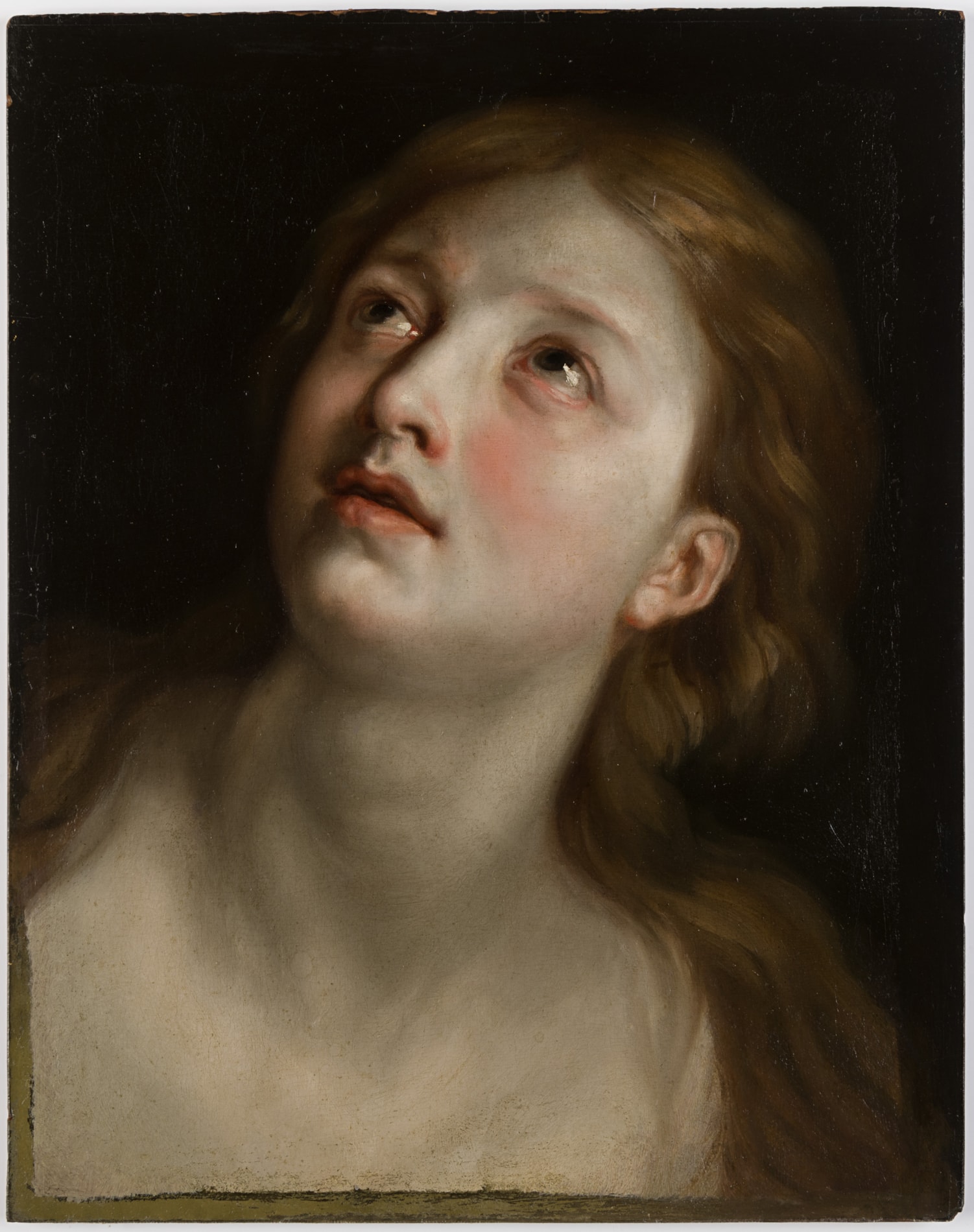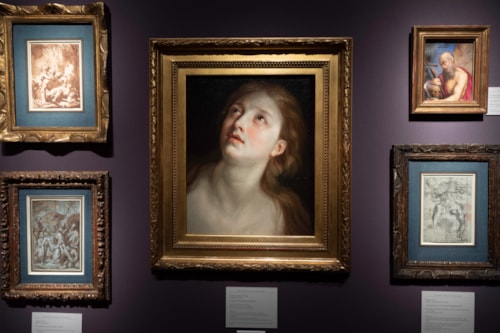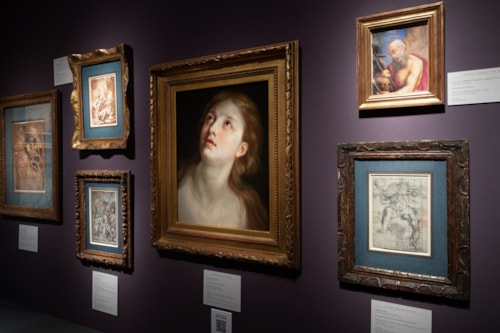Anton Raphael MENGS
(Aussig 1728 - Rome 1779)
Study for the Head of Mary Magdalene
Oil on paper, laid down on board.
386 x 305 mm. (15 1/4 x 12 in.) [image]
422 x 337 mm. (16 5/8 x 13 1/4 in.) [board]
386 x 305 mm. (15 1/4 x 12 in.) [image]
422 x 337 mm. (16 5/8 x 13 1/4 in.) [board]
This splendid oil sketch on paper is a study for the head of the Magdalene in one of Anton Raphael Mengs’s most significant late works; the large panel painting Noli Me Tangere of 1771, in the collection of All Souls College in Oxford and until recently on loan to the National Gallery in London. Intended for their chapel, the altarpiece was commissioned from Mengs in 1769 by All Souls College, for the sum of 600 Roman scudi (approximately £315), through the auspices of the British Ambassador in Madrid. (As recorded in the College records, on 7 April 1769 it was decided ‘that a Picture, representing the appearance of our Saviour to Mary in the Garden after his resurrection, be procured from the Hands of Mengs, a celebrated Painter now at Madrid, to be put up over the Altar in the Chapel.’) The artist left Spain for Italy not long afterwards, however, and the painting was only begun after he had arrived back in Rome in the spring of 1771.
Mengs worked on the large panel in a rented studio at the Villa Medici, where it was exhibited after its completion in September 1771, having earlier been shown to the Pope. As an English correspondent in Rome wrote, in a letter to the Warden of All Souls College, ‘The Picture is finish’d and I really think among the very best that ever I saw of his painting. In the Christ there is a great dignity and meekness, in the Magdalena the remains of Grief with a mixture of surprize and joy, is wonderfully express’d. The disposition of the Figures is very agreeable, the colouring strong and clear, but very harmonious and true…Those who have seen it admired it much.’ Similarly, a modern scholar has noted that ‘The painting is a very revealing example of Mengs’s eclectic approach, with borrowings from classical antiquity (the figure of Christ is deeply indebted to the Apollo Belvedere), and – in the loose and luminous landscape and in the general sweetness of expression – to Titian and Correggio.’
Although Mengs completed the actual painting of the altarpiece in around six weeks, he must have produced a number of preparatory studies and sketches for the picture beforehand. Preliminary chalk drawings for the figure and head of the Magdalene in the Noli me tangere altarpiece are today in the Prado in Madrid, the Albertina in Vienna and in a private collection in Malta. A similar oil sketch of this type, preparatory for the head of Christ in the painting, is in the Library at All Souls College in Oxford. As the Mengs scholar Steffi Roettgen has described that oil sketch, in terms equally applicable to this newly-rediscovered study for the head of the Magdalene in the same painting, ‘The fact that so carefully executed a head study was made to the same size as the picture throws a revealing light on the artist’s method of working. Mengs must have made an incredible number of drawings and oil studies for all his larger compositions...The study of the head differs only slightly from the finished painting. However, in expression, brushwork and liveliness it is superior.’
The head of the Magdalene in the All Souls Noli me tangere was much admired by some contemporary writers. As one young German scholar, on a visit to All Souls College in 1782, noted, ‘the chapel is particularly beautiful…over the altar here [is] a fine painting of Mengs…The painting represented Mary Magdalene when she first suddenly sees Jesus standing before her, and falls at His feet. And in her countenance pain, joy, grief, in short almost all of the strongest of our passions, are expressed in so masterly a manner, that no man of true taste was ever tired of contemplating it; the longer it is looked at the more it is admired.’
The first owner of this oil sketch was Meng’s son-in-law, the Spanish engraver Manuel Salvador Carmona (1734-1820), who married the painter’s daughter Anna Maria in 1778. This sketch is noted as being in Carmona’s collection in Madrid some ten years later, when it is mentioned by the 18th century Spanish painter Antonio Ponz in his magisterial book Viage de España, en que se da noticia de las cosas mas apreciables, y dignas de saberse, que hay en ella (Voyage Around Spain, In Which There is News of the Most Significant and Worthwhile Things in the Country), published in eighteen volumes between 1772 and 1794. The Viage de España was based on a trip Ponz made throughout Spain in 1771, during which he recorded all the notable works of art he saw. The present sheet is noted in the volume devoted to the region of Catalonia: ‘Don Manuel Salvador Carmona, Engraver of the Privy Chamber of His Majesty and son-in-law of Don Antonio Mengs, has different works of his. The paintings are a profile portrait of himself, a Head of the Magdalen... and some other small-scale paintings: different drawings on white and blue paper...’
Mengs worked on the large panel in a rented studio at the Villa Medici, where it was exhibited after its completion in September 1771, having earlier been shown to the Pope. As an English correspondent in Rome wrote, in a letter to the Warden of All Souls College, ‘The Picture is finish’d and I really think among the very best that ever I saw of his painting. In the Christ there is a great dignity and meekness, in the Magdalena the remains of Grief with a mixture of surprize and joy, is wonderfully express’d. The disposition of the Figures is very agreeable, the colouring strong and clear, but very harmonious and true…Those who have seen it admired it much.’ Similarly, a modern scholar has noted that ‘The painting is a very revealing example of Mengs’s eclectic approach, with borrowings from classical antiquity (the figure of Christ is deeply indebted to the Apollo Belvedere), and – in the loose and luminous landscape and in the general sweetness of expression – to Titian and Correggio.’
Although Mengs completed the actual painting of the altarpiece in around six weeks, he must have produced a number of preparatory studies and sketches for the picture beforehand. Preliminary chalk drawings for the figure and head of the Magdalene in the Noli me tangere altarpiece are today in the Prado in Madrid, the Albertina in Vienna and in a private collection in Malta. A similar oil sketch of this type, preparatory for the head of Christ in the painting, is in the Library at All Souls College in Oxford. As the Mengs scholar Steffi Roettgen has described that oil sketch, in terms equally applicable to this newly-rediscovered study for the head of the Magdalene in the same painting, ‘The fact that so carefully executed a head study was made to the same size as the picture throws a revealing light on the artist’s method of working. Mengs must have made an incredible number of drawings and oil studies for all his larger compositions...The study of the head differs only slightly from the finished painting. However, in expression, brushwork and liveliness it is superior.’
The head of the Magdalene in the All Souls Noli me tangere was much admired by some contemporary writers. As one young German scholar, on a visit to All Souls College in 1782, noted, ‘the chapel is particularly beautiful…over the altar here [is] a fine painting of Mengs…The painting represented Mary Magdalene when she first suddenly sees Jesus standing before her, and falls at His feet. And in her countenance pain, joy, grief, in short almost all of the strongest of our passions, are expressed in so masterly a manner, that no man of true taste was ever tired of contemplating it; the longer it is looked at the more it is admired.’
The first owner of this oil sketch was Meng’s son-in-law, the Spanish engraver Manuel Salvador Carmona (1734-1820), who married the painter’s daughter Anna Maria in 1778. This sketch is noted as being in Carmona’s collection in Madrid some ten years later, when it is mentioned by the 18th century Spanish painter Antonio Ponz in his magisterial book Viage de España, en que se da noticia de las cosas mas apreciables, y dignas de saberse, que hay en ella (Voyage Around Spain, In Which There is News of the Most Significant and Worthwhile Things in the Country), published in eighteen volumes between 1772 and 1794. The Viage de España was based on a trip Ponz made throughout Spain in 1771, during which he recorded all the notable works of art he saw. The present sheet is noted in the volume devoted to the region of Catalonia: ‘Don Manuel Salvador Carmona, Engraver of the Privy Chamber of His Majesty and son-in-law of Don Antonio Mengs, has different works of his. The paintings are a profile portrait of himself, a Head of the Magdalen... and some other small-scale paintings: different drawings on white and blue paper...’
Born in Bohemia, Anton Raphael Mengs was the son and pupil of the Danish painter Ismael Mengs, the court painter at Dresden. He grew up there, together with his two sisters (who were also artists), before moving with the rest of his family to Rome in 1741, when he was twelve years old. Although he returned occasionally to Dresden, to work at the Saxon court, he was to spend most of the rest of his life in Italy, converting to Catholicism and becoming a leading figure in the artistic community in Rome. Mengs received several important portrait commissions, including many from British travellers to Italy, and also painted a number of significant public works. Alongside Anton von Maron, he painted the ceiling fresco on the nave of the church of Sant’ Eusebio between 1757 and 1758, while his best-known work is the Parnassus ceiling in the Villa Albani, completed in 1761.
That same year he travelled to Madrid, where he had been appointed pintor de camára to the Spanish King Charles III, and he remained in Spain for most of the next decade. Mengs was back in Rome by 1771 and the following year was elected principe of the Accademia di San Luca. After painting an altarpiece for Saint Peter’s and decorating the Stanza dei Papiri in the Vatican Library in 1772 for Pope Clement XIV, he returned to Madrid in 1774. Two years later, on the grounds of poor health, the artist left the Spanish court for good and retired to Italy. Mengs was also an important writer and theorist on art, as well as an occasional art dealer, and by the time of his death was arguably the most celebrated painter in Europe. As the 18th century Italian writer and antiquarian G. L. Bianconi wrote of the artist, a year after his death, ‘There has never been a painter in all the world more sought after by rulers than Mengs; it seemed that they could not talk to him without losing their hearts to him, and conferring commissions.’
That same year he travelled to Madrid, where he had been appointed pintor de camára to the Spanish King Charles III, and he remained in Spain for most of the next decade. Mengs was back in Rome by 1771 and the following year was elected principe of the Accademia di San Luca. After painting an altarpiece for Saint Peter’s and decorating the Stanza dei Papiri in the Vatican Library in 1772 for Pope Clement XIV, he returned to Madrid in 1774. Two years later, on the grounds of poor health, the artist left the Spanish court for good and retired to Italy. Mengs was also an important writer and theorist on art, as well as an occasional art dealer, and by the time of his death was arguably the most celebrated painter in Europe. As the 18th century Italian writer and antiquarian G. L. Bianconi wrote of the artist, a year after his death, ‘There has never been a painter in all the world more sought after by rulers than Mengs; it seemed that they could not talk to him without losing their hearts to him, and conferring commissions.’
Provenance
The artist’s son-in-law, Manuel Salvador Carmona, Madrid
Acquired from him by Tomás de Veri y Togores, Palma de Mallorca, Mallorca
The Marqués de Ariany y de la Cenia, Mallorca
Thence by descent to the Cotoner collection, Marattxí, Mallorca, by 1920.
Acquired from him by Tomás de Veri y Togores, Palma de Mallorca, Mallorca
The Marqués de Ariany y de la Cenia, Mallorca
Thence by descent to the Cotoner collection, Marattxí, Mallorca, by 1920.
Literature
Antonio Ponz, Viage de España, Madrid, 1788, Vol.XIV, p.53, no.11; Tomás de Veri, Caudros notables de Mallorca. Principales colecciones de pinturas que existen en la Isla de Mallorca, Madrid, 1920, pl.XVI; Dieter Honisch, Anton Raphael Mengs und die Bildform des Frühklassizismus, Recklinghausen, 1965, p.131, no.304 and p.153, no.443; Steffi Roettgen, Anton Raphael Mengs 1728-1779 and his British Patrons, exhibition catalogue, London, 1993, p.108, under no.30; Steffi Roettgen, Anton Raphael Mengs 1729-1779, Munich, 1999, Vol.I (Das malerische und zeichnerische Werk), p.110, under no.66, and p.111, no.67.







